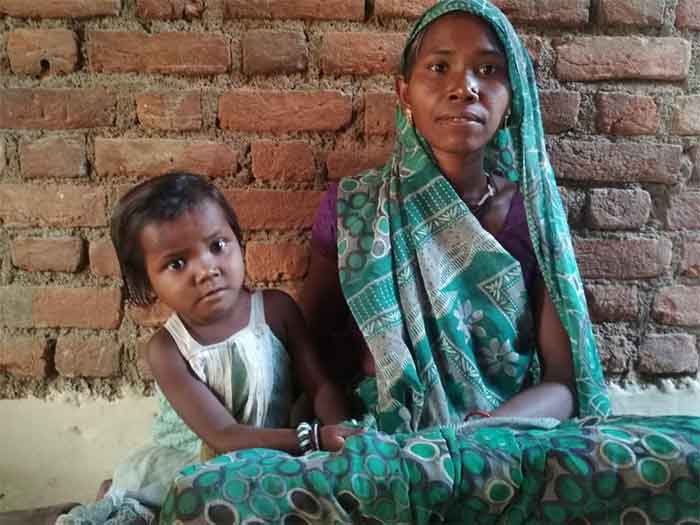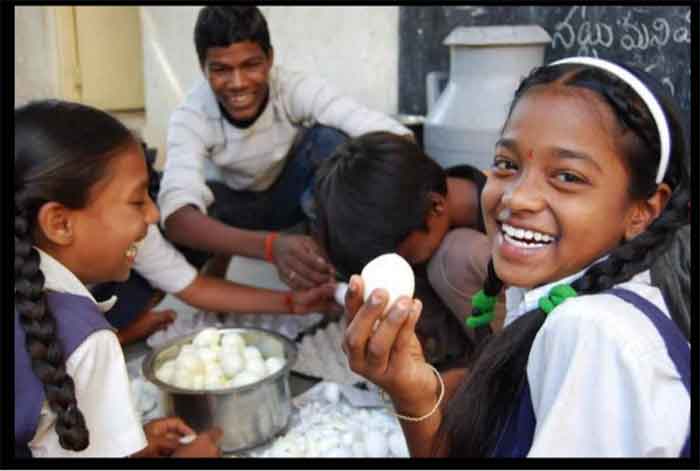
The Modi government’s publicity blitzkrieg around the 75th anniversary of independence masks a steadily worsening hunger and livelihood crisis. Recent research has revealed growing numbers of severely malnourished children – the majority of them Dalit or tribal – which calls for urgent intervention. Yet, the government is perversely placing fresh hurdles before India’s severely malnourished children and the rations that are their lifeline.
Earlier this week, reports surfaced from Haryana of people being denied their legally entitled rations, for refusing to buy a ‘mandatory’ national flag along with it. In a viral video, which was also tweeted by BJP MP Varun Gandhi – whose party is in power in Haryana – poor beneficiaries can be seen complaining about this new ‘patriotic’ rule. The move is part of the government’s Har Ghar Tiranga campaign which seeks to celebrate the 75th anniversary of the nation’s independence by asking every Indian to fly the national flag over their house.
This ongoing nightmare is the reality of life in India today for an increasingly large number of its citizens on the 75th year of its independence. The latest (statistical) confirmation of this reality comes in the form of the fifth National Family Health Survey (NFHS-5) – the most comprehensive survey of its kind – which reports some alarming trends in the nutritional status of very young children in India, despite partial improvements (see Table).
| Indicators (Children under 5) | NFHS-4 (2015-2016) | NFHS-5 (2019-2021) |
| Anaemic (aged 6 to 59 months) | 58.6% | 67.1% |
| Stunting (low height for age) | 38.4% | 35.5% |
| Wasting (low body weight for height)) | 21.0% | 19.3% |
| Severe wasting (extremely low weight for height) | 7.5% | 7.7% |
| Underweight (low weight for age) | 35.8% | 32.1% |
The first of these trends is the nearly 10% jump in the number of anaemic children, indicating both reduced nourishment and food diversity; the second, an increase in ‘severe acute malnutrition’ (generally regarded as the most dangerous form of malnutrition owing to the high risk of mortality) in malnutrition ‘hotspots’; the third, an increase in severe acute malnutrition in regions previously not known for it. These trends were highlighted in a new analysis of district-wise data from the NFHS-5, published in the reputed BMJ Global Health.
Here are the key findings from the analysis:
- Overall increase in severe acute malnutrition was marginal (from 7.5% in NFHS-4 to 7.7% in NFHS-5), but conceals the fact that 341 districts (out of a total 707 districts covered) recorded an increasing trend in severe acute malnutrition in children aged below five, between NFHS-4 and NFHS-5.
- Of these 341 districts, 115 recorded a manifold increase; further, 50 districts in the ‘medium’ or ‘low prevalence’ categories in NFHS-4 have moved to ‘serious’ or ‘very serious’ or ‘critical’ categories in NHFS-5.
- Another 65 districts showed a rapid increase in severe acute malnutrition, but being in the ‘low prevalence’ category in NFHS-4, they are marked as ‘medium prevalence’ category in NFHS-5, masking the steep nature of the increase.
- Out of 111 districts clustered in four malnutrition ‘hotspots’, 11 were ‘critical’, 72 were ‘very serious’ and 28 were ‘serious’; with all 111 requiring urgent policy intervention.
- Of these 111 under-nutrition hotspot districts, 35 reported further worsening of severe acute malnutrition. These include nine districts each from Gujarat and Bihar, five from Madhya Pradesh; three each from Jharkhand and Odisha, two districts from Uttar Pradesh, and one each from Karnataka, Maharashtra, Rajasthan and West Bengal. Bellary in Karnataka is the only district from south India to appear in this category.
- Some districts and regions previously not known for high malnutrition – such as Kashmir and Dakshin Kannada in Karnataka – too are showing increasing prevalence of severe acute malnutrition.
- The highest increase in severe acute malnutrition between NFHS-4 and NFHS-5 survey was recorded in Karimganj district in Assam (6.1%– 30.5%); Sheohar in Bihar (4.3%–21.4%); Saraikela Kharsawan in Jharkhand (8.9%–23%); North Tripura district in Tripura (4.3%–18.1%); and Kupwara (1%–14.7%) and Shopian (3.8%–17.4%) in Jammu and Kashmir.
- Additionally, severe acute malnutrition spiked by more than 10% in 17 other districts in the same period in the following states: Uttar Pradesh (4), two each in Bihar, J&K, Karnataka, Maharashtra and Telangana, and one district each from Gujarat, Madhya Pradesh and West Bengal. In contrast, 21 districts reported more than a 10% reduction in severe acute malnutrition.
- Both severe acute malnutrition and multidimensional nutritional failures (which takes into account wider factors such as household food security and access to health services) are prevalent in the affected districts. This is especially alarming as the combination implies a high risk of mortality and morbidity for young children unless remedied in time.
Lockdown impacts not reflected
It is important to note that alarming as these trends may be, they only partially reflect the catastrophic impact of pandemic-related economic disruptions. This is because the major chunk of NFHS-5 data was collected between June 2019 and February 2020, a month before Covid-19 hit India and a panicky Union government implemented its ill-conceived, and socially and economically disastrous national lockdown.
 The combined effect of the pandemic and the lockdown resulted in the national GDP dipping by an unprecedented -7.3% and pushed unemployment, already at its highest in 45 years in 2019, to a historic peak in the post-pandemic period. A 2022 report by the international charity Oxfam estimated that no less than 4.6 crore Indians were pushed into extreme poverty in 2020 alone. Nearly a dozen other surveys and reports, including official ones, have confirmed the severe impacts this has had on incomes, nutrition and health for the majority of the population.
The combined effect of the pandemic and the lockdown resulted in the national GDP dipping by an unprecedented -7.3% and pushed unemployment, already at its highest in 45 years in 2019, to a historic peak in the post-pandemic period. A 2022 report by the international charity Oxfam estimated that no less than 4.6 crore Indians were pushed into extreme poverty in 2020 alone. Nearly a dozen other surveys and reports, including official ones, have confirmed the severe impacts this has had on incomes, nutrition and health for the majority of the population.
These include the National Sample Survey Office’s periodic labour force survey (PLFS), surveys by the Union Health Ministry and the Niti Aayog’s sustainable development goals (SDG) index; independent surveys such as Longitudinal Ageing Study in India (LASI), ICE360 Survey and those conducted by independent agencies such as Right to Food campaign and Azim Premji University; as well as by international reports by the World Bank, the International Monetary Fund, Pew Research Centre and the Brookings Institution, reports such as Global Hunger Index and Global Nutrition Report (for details, see earlier articles by this writer here and here).
A failing Poshan Abhiyan
Leaving aside questions about the underlying causes for the present distress, what can be done to alleviate the situation for India’s starving majority, especially young children? According to the authors of the BMJ paper, addressing lacunae in the Supplementary Nutrition Programme implemented through Anganwadis is the key. They identify several structural factors that hamper Anganwadis’ effectiveness, especially in poor-performing states, including “inadequate financing and infrastructure, prejudicial caste-based social relationships, seasonal labour migration, governance failures, inadequate/delayed salaries, punitive supervision and high workload.”
“From a policy perspective, the most important issue which has emerged from the NFHS-5 data is the failure of the flagship Poshan Abhiyan scheme in addressing the fundamental drivers of malnutrition in India,” says Sabu Kochupurackal Ulahannan, a public health researcher with the Bangalore-based Institute of Public Health and lead author of the BMJ paper. According to him, the scheme is largely focused on secondary activities such as awareness creation, data collection, monitoring and evaluation etc. “It is not more ‘awareness’ that the malnourished need, but adequate availability and access to food,” he says. Sabu also points out that in socio-economic terms, the NFHS-5 data once again confirms that malnutrition in India is concentrated in the Dalit and tribal populations, calling for urgent attention from policymakers.
However, recent developments show that far from addressing these issues, official policy is actually worsening the nutritional crisis. An investigative report by The Reporters’ Collective revealed how the Union government has been compelling states to make Unique Identification number (UID) compulsory for all Anganwadi beneficiaries, insisting that young mothers and children produce their Aadhaar cards on each visit to the local anganwadi. The report traces how the government has been consistently pushing for the nutrition programme to be linked with Aadhaar, especially to boost the Poshan Tracker mobile app which anganwadi workers are required to feed details of beneficiaries and services into. On 30 November 2021, the Women and Child Development Ministry even issued an ultimatum to the states to link Aadhaar details of beneficiaries with Poshan Tracker, stating that funds would now on be allocated based on data fed into the app, thus compulsively herding the nation’s youngest citizens into what is essentially a population-scale data harvesting mechanism.
Linking Aadhar to rations has been disastrous for India’s poor, especially those in remote districts where the power supply is often poor and technical glitches in the biometric system go unaddressed. As early as 2018, the Right to Food campaign had released a list of 57 starvation deaths in nine states from 2015 to 2018 – of these, 27 were identified as resulting from Aadhaar-related issues, while at least 19 were found to be directly linked to Aadhaar exclusion. (For more details, see this 2018 report, ‘How Aadhaar is devouring India’s hungry’)
Return of the Raj
Writing in 2015 about famines in India during the British Raj, which killed anywhere between 25.2 million to 44.3 million people (the estimates vary), Debarshi Das recounts the incredibly cruel conditions the colonial administration imposed on the starving population to deny relief. “Unlike the Mughals, the British administration had a dim view about the natives’ moral fibre. It was suspected that they were pretending to be starving and trying to pick Her Majesty’s pocket. To qualify for relief the victims would have to pass ‘distance test’ and perform hard labour. During the Deccan famine of the 1870s, relief camps of the government were purposefully set up far away from villages. No adult male or older children who lived within a 10 mile radius of the camp could apply for relief. This meant that relief seekers would have to walk more than 10 miles to prove that they are not faking. Beneficiaries would be required to perform hard manual labour under the relentless famine sun. Fines would be deducted from their wage if the work failed to meet the standards specified by the government. These tests would filter out cheats, it was hoped.”
At present, only 23% of children below five years of age in India have Aadhaar identification according to official records. There is also a 2018 Supreme Court ruling stating that children can’t be denied any services or benefits for the lack of the unique identification number. By making Aaadhar mandatory for Anganwadi meals, the Modi government is putting up a digital ‘distance test’ before millions of severely malnourished children, whose growing numbers have been revealed by its own official survey.
By making even basic nutrition for children subject to dubious conditions, the Modi government is behaving less like an elected government in a democracy – or for that matter, like the imperial Mughals – but a ruthlessly extractive British Raj, which forced India’s starving poor to jump through hoops for scraps of the very food they helped produce. Except, to the best of our knowledge, the British never forced them to wave the Union Jack to ‘celebrate’ their own immiseration.
Sajai Jose is a freelance journalist and researcher
















































